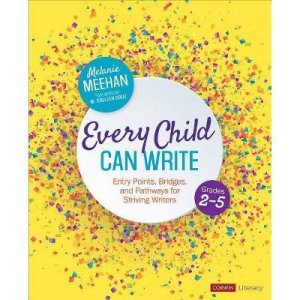Teacher to Teacher: The Importance of Charts in a Writing Classroom
By Lynne R. Dorfman
When I first read Reading with Meaning: Teaching Comprehension in the Primary Grades (2013), I was struck by Debbie Miller’s question: “How can we hold thinking—making it both permanent and visible?” I’ve always been a big fan of anchor charts, using them as visible representations of students’ thinking. Not only does the collective thinking become permanent and visible, but the charts can also serve many purposes. Charts help students achieve greater independence by providing the information they may need o plan, draft, revise, and edit their writing.
Naturally, when Melanie asked me if I was interested in being part of her blog tour for her new book, Every Child Can Write, I was thrilled to be able to take a closer look at Chapter 6: Co-Create Classroom Charts as Pathways Toward Independence. Immediately, I was captured by Melanie’s statement of rationale for using classroom charts, linking their use with Universal Design for Learning (UDL), a way of teaching and learning that helps teachers give all students an equal opportunity to succeed. Yes! It made perfect sense that charts can remove obstacles to success by building in flexibility in the ways learners can access information.
Melanie opens with an anecdote that describes how she used charts to help her daughter learn to cook, sharing that, as in the gradual release of responsibility model, the more her daughter cooked, the more competent and confident she became. One day, the cooking charts were taken down. Cecily had reached her goal.
Melanie gives us many reasons to use charts:
- They can actually replace the minilessons for thriving writers.

- Strong writers use them as memory joggers and scaffolds.
- They provide choices or options student writers may want to try.
These big ideas are explored in this chapter. First, Melanie tells us we should decide on the types and purposes of the charts we display in our classrooms. The important thing to remember here is that a chart is a living, breathing tool. It can change and grow as the class thinking evolves. Always accessible and reflective of the work the students do, it does not need to be “perfect, beautiful, or laminated.” The important thing is that charts are created as a joint effort of the students and the teacher. A sense of ownership fosters a sense of commitment and pride in using the information the chart provides.
Chapter 6 explores four types of teacher-created charts: anchor, procedural, strategy, and inquiry. Meehan defines anchor charts as instructional tools that provide the overall skills necessary to complete a task. One use of this type of chart is to reflect the expectations for the overall tasks of each genre of writing.



